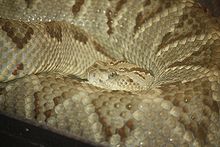- Crotalus simus
-
Crotalus simus 
Yucatán Neotropical rattlesnake
(Crotalus simus tzabcan)Scientific classification Kingdom: Animalia Phylum: Chordata Subphylum: Vertebrata Class: Reptilia Order: Squamata Suborder: Serpentes Family: Viperidae Subfamily: Crotalinae Genus: Crotalus Species: C. simus Binomial name Crotalus simus
Latreille In Sonnini & Latreille, 1801Synonyms - Crotalus simus - Latreille In Sonnini & Latreille, 1801
- Caudisona durissa - Cope, 1861
- C[rotalus]. terrificus - Cope In Yarrow In Wheeler, 1875
- Crotalus durissus durissus - Klauber, 1936
- C[rotalus] terrificus copeanus - Amaral, 1937
- Crotalus (Crotalus) durissus durissus - Peters & Orejas-Miranda, 1970
- Crotalus durissus neoleonensis - Juliá-Zertuche & Treviño-Saldaña, 1978 (nomen nudum)[1][2]
- Common names: Middle American rattlesnake,[1] Central American rattlesnake,[3], Tzabcan (local name for subspecies C. s. tzabcan).
Crotalus simus is a venomous pitviper species found in Mexico and Central America. The specific epithet is Latin for "flat nosed"; likely an allusion to the fact that its head is relatively blunt when compared with the lanceheads (Bothrops). Currently, 3 subspecies are recognized, including the nominate subspecies described here.[4]
Contents
Description
Adults commonly exceed 130 cm in length, with males growing larger than females. Large males reach 140-160cm in some populations. The maximum reported length is 180 cm.[1]
The body has an exceedingly rough appearance as the normal dorsal scale keels are accentuated into protuberances or tuberculations. This is most apparent on the scale rows to either side of the body with a decreasing intensity in the lower rows. The vertebral scales are about as prominently keeled as the fourth row down on the flanks (with the vertebral scales as the first row).[3]
Geographic range
Found from Mexico in southwestern Michoacán on the Pacific coast, and Veracruz and the Yucatan Peninsula on the Atlantic coast, south through Belize, Guatemala, El Salvador, Honduras and Nicaragua to west-central Costa Rica. It is absent from Panama, but apparently does occur on the Atlantic side of Colombia.[1] The type locality given is "Ceylan," which is incorrect.[2]
Habitat
Usually found in regions that are semiarid, including tropical forests that are dry or very dry, thorn woodland and arid scrub forest. It also occurs in mesic forests with relatively dry open areas.[1]
Cultural Significance
To the Mayans and their living descendants, the Yucatan subspecies (C. s. tzabcan) was greatly revered. The word tzabcan means rattlesnake in Mayan. It is unknown what the rattlesnake actually symbolizes, but many temples have had rattlesnake shapes carved. Shamans also dry and roast snakes, grinding them into a powder used as medicine.[citation needed]
Venom
Bites from this species are similar to rattlesnake bites in the United States. Local symptoms may be severe, with pain, massive swelling, blistering and necrosis that often lead to physicians performing fasciotomies and in some cases amputations. Systemic effects involving hemostatic disturbances are rare, as are renal failure and neurotoxicity. Only venom from neonates contains crotoxin; a constituent typically found in C. durissus venom that produces neurotoxic symptoms.[5]
Subspecies
Subspecies[4] Taxon author[4] Common name[3] Geographic range[3] C. s. culminatus Klauber, 1952 Northwestern Neotropical rattlesnake Mexico in southwestern Michoacán, southern and western Morelos, Guerrero and southwestern Oaxaca. It probably also occurs in extreme western Puebla and possibly in the Mexican Federal District. C. s. simus Latreille In Sonnini & Latreille, 1801 Central American rattlesnake Southeastern Mexico (central Veracruz, southeastern Oaxaca, Tabasco and Chiapas), central and southern Guatemala, western and southern Honduras, southern Belize, El Salvador, southwestern Nicaragua, and northwestern and central Costa Rica. C. s. tzabcan Klauber, 1952 Yucatán Neotropical rattlesnake Mexico (Yucatán, Campeche, Quintana Roo and eastern Tabasco), northern Guatemala and northern Belize. Taxonomy
Previously, until 2004, the description for this form was listed as the nominate subspecies for the tropical rattlesnake, C. durissus.[2] Molecular genetic data suggest that the taxa culminatus and tzabcan should be considered as separate species from C. simus [6]
See also
- List of crotaline species and subspecies
- Crotalus by common name
- Crotalus by taxonomic synonyms
- Crotalinae by common name
- Crotalinae by taxonomic synonyms
- Snakebite
References
- ^ a b c d e Campbell, J.A.; Lamar W.W. (2004). The Venomous Reptiles of the Western Hemisphere. Ithaca and London: Comstock Publishing Associates. pp. 870 pp. 1500 plates. ISBN 0-8014-4141-2..
- ^ a b c McDiarmid RW, Campbell JA, Touré T. 1999. Snake Species of the World: A Taxonomic and Geographic Reference, vol. 1. Herpetologists' League. 511 pp. ISBN 1-893777-00-6 (series). ISBN 1-893777-01-4 (volume).
- ^ a b c d Klauber LM. 1997. Rattlesnakes: Their Habitats, Life Histories, and Influence on Mankind. Second Edition. 2 volumes. Reprint, University of California Press, Berkeley. ISBN 0-520-21056-5.
- ^ a b c "Crotalus simus". Integrated Taxonomic Information System. http://www.itis.gov/servlet/SingleRpt/SingleRpt?search_topic=TSN&search_value=727493. Retrieved 28 August 2007.
- ^ Warrell DA. 2004. Snakebites in Central and South America: Epidemiology, Clinical Features, and Clinical Management. In Campbell JA, Lamar WW. 2004. The Venomous Reptiles of the Western Hemisphere. Comstock Publishing Associates, Ithaca and London. 870 pp. 1500 plates. ISBN 0-8014-4141-2.
- ^ Wüster, W., J.E. Ferguson, J.A. Quijada-Mascareñas, C.E. Pook, M.G. Salomão & R.S. Thorpe (2005) Tracing an invasion: landbridges, refugia and the phylogeography of the Neotropical rattlesnake (Serpentes: Viperidae: Crotalus durissus). Molecular Ecology 14(4): 1095-1108.
Categories:- Crotalus
- Reptiles of Guatemala
Wikimedia Foundation. 2010.
